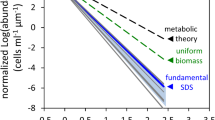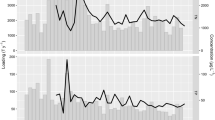Abstract
Driving factors of phytoplankton spring blooms have been discussed since long, but rarely analyzed quantitatively. Here, we use a mechanistic size-based ecosystem model to reconstruct observations made during the Kiel mesocosm experiments (2005–2006). The model accurately hindcasts highly variable bloom developments including community shifts in cell size. Under low light, phytoplankton dynamics was mostly controlled by selective mesozooplankton grazing. Selective grazing also explains initial dominance of large diatoms under high light conditions. All blooms were mainly terminated by aggregation and sedimentation. Allometries in nutrient uptake capabilities led to a delayed, post-bloom dominance of small species. In general, biomass and trait dynamics revealed many mutual dependencies, while growth factors decoupled from the respective selective forces. A size shift induced by one factor often changed the growth dependency on other factors. Within climate change scenarios, these indirect effects produced large sensitivities of ecosystem fluxes to the size distribution of winter phytoplankton. These sensitivities exceeded those found for changes in vertical mixing, whereas temperature changes only had minimal impacts.







Similar content being viewed by others
References
Aberle N, Lengfellner K, Sommer U (2007) Spring bloom succession, grazing impact and herbivore selectivity of ciliate communities in response to winter warming. Oecologia 150:668–681
Abrams PA (1995) Implications of dynamically variable traits for identifying, classifying and measuring direct and indirect effects in ecological communities. Am Nat 146:112–134
Alldredge A, Passow U, Logan B (1993) The abundance and significance of a class of large, transparent organic particles in the ocean. Deep Sea Res Part I Oceanogr Res Pap 40:1131–1140
Alldredge AL, Gotschalk C, Passow U, Riebesell U (1995) Mass aggregation of diatom blooms: insights from a mesocosm study. Deep Sea Res Part II 42:9–27
Armstrong RA (2003) A hybrid spectral representation of phytoplankton growth and zooplankton response: The “control rod” model of plankton interaction. Deep Sea Res II 50:2895–2916
Baird M (2010) Limits to prediction in a size-resolved pelagic ecosystem model. J Plankton Res 32:1131–1146
Banas N (2011) Adding rich trophic interactions to a size-spectral plankton model: emergent diversity patterns and limits on predictability. Ecol Mod 222:2663–2675
Berggreen U, Hansen B, Kiørboe T (1988) Food size spectra, ingestion and growth of the copepod Acartia tonsa during development: implications for determination of copepod production. Mar Biol 99:341–352
Bolker B, Holyoak M, Křivan V, Rowe L, Schmitz O (2003) Connecting theoretical and empirical studies of trait-mediated interactions. Ecology 84:1101–1114
Cermeño P, Marañón E, Rodríguez J, Fernández E (2005) Large-sized phytoplankton sustain higher carbon-specific photosynthesis than smaller cells in a coastal eutrophic ecosystem. Mar Ecol Progr Ser 297:51–60
Daufresne M, Lengfellner K, Sommer U (2009) Global warming benefits the small in aquatic ecosystems. Proc Natl Acad Sci 106:12,788
Fuchs H, Franks P (2010) Plankton community properties determined by nutrients and size-selective feeding. Mar Ecol Progr Ser 413:1–15
Gaedke U, Rubenstroth-Bauer M, Wiegand I, Tirok K, Aberle N, Breithaupt P, Lengfellner K, Wohlers J, Sommer U (2010) Biotic interactions may overrule direct climate effects on spring phytoplankton dynamics. Global Change Biol 16:1122–1136
Geider RJ, MacIntyre HL, Kana TM (1998) A dynamic regulatory model of phytoplanktonic acclimation to light, nutrients, and temperature. Lim Ocean 43:679–694
Gerten D, Adrian R (2000) Climate-driven changes in spring plankton dynamics and the sensitivity of shallow polymictic lakes to the North Atlantic Oscillation. Lim Ocean 45:1058–1066
Greene C (1983) Selective predation in freshwater zooplankton communities. Internationale Revue der gesamten Hydrobiologie und Hydrographie 68:297–315
Hillebrand H, Dürselen CD, Kirschtel D, Pollingher U, Zohary T (1999) Biovolume calculation for pelagic and benthic microalgae. J Phycol 35:403–424
Jackson GA (1990) A model of the formation of marine algal flocs by physical coagulation processes. Deep Sea Res 37:1197 – 1211
Jansen S (2008) Copepods grazing on Coscinodiscus wailesii: a question of size? Helgoland Mar Res 62:251–255
Kiørboe T, Lundsgaard C, Olesen M, Hansen JLS (1994) Aggregation and sedimentation processes during a spring phytoplankton bloom: a field experiment to test coagulation theory. J Mar Res 52:297–323
Köhler P, Wirtz K (2002) Linear understanding of a huge aquatic ecosystem model using a group-collecting sensitivity study. Environ Model Softw 17:613–635
Kriest I, Evans G (1999) Representing phytoplankton aggregates in biogeochemical models. Deep Sea Res 46:1841–1859
Lewontin R (1997) Dobzhansky’s genetics and the origin of species: is it still relevant? Genetics 147:351–355
Lunau M, Lemke A, Dellwig O, Simon M (2006) Physical and biogeochemical controls of microaggregate dynamics in a tidally affected coastal ecosystem. Lim Ocean 51:847–859
Maerz J, Wirtz K (2009) Resolving physically and biologically driven suspended particulate matter dynamics in a tidal basin with a distribution-based model. Est Coast Shelf Sci 84:128–138
Menden-Deuer S, Lessard EJ (2000) Carbon to volume relationships for dinoflagellates, diatoms, and other protist plankton. Lim Ocean 45:569–579
Olesen M (1995) Comparison of the sedimentation of a diatom spring bloom and of a subsurface chlorophyll maximum. Mar Biol 121:541–547
Pagano M (2008) Feeding of tropical cladocerans (Moina micrura, Diaphanosoma excisum) and rotifer (Brachionus calyciflorus) on natural phytoplankton: effect of phytoplankton size–structure. J Plankton Res 30:401
Peeters F, Straile D, Lorke A, Ollinger D (2007) Turbulent mixing and phytoplankton spring bloom development in a deep lake. Lim Ocean 52:286–298
Porter E, Sanford L, Gust G, Porter F (2004) Combined water-column mixing and benthic boundary-layer flow in mesocosms: key for realistic benthic-pelagic coupling studies. Mar Ecol Progr Ser 271:43–60
Putt M, Stoecker D (1989) An experimentally determined carbon: volume ratio for marine “oligotrichous” ciliates from estuarine and coastal waters. Lim Ocean 34:1097–1103
Raven JA, Waite AM (2004) The evolution of silicification in diatoms: inescapable sinking and sinking as escape? New Phytol 162:45–61
Richardson T, Cullen J (1995) Changes in buoyancy and chemical composition during growth of a coastal marine diatom: ecological and biogeochemical consequences. Mar Ecol Progr Ser 128:77–90
Richman S, Heinle D, Huff R (1977) Grazing by adult estuarine calanoid copepods of the Chesapeake Bay. Mar Biol 42:69–84
Riebesell U (1989) Comparison of sinking and sedimentation rate measurements in a diatom winter/spring bloom. Mar Ecol Progr Ser 54:109–119
Smayda TJ (1970) The suspension and sinking of phytoplankton in the sea. Oceanogr Mar Biol Annu Rev 8:353–414
Smetacek V (1985) Role of sinking in diatom life-history cycles: ecological, evolutionary and geological significance. Mar Biol 84:239–251
Smetacek V (2001) A watery arms race. Nature 411:745
Smetacek V, Assmy P, Henjes J (2004) The role of grazing in structuring southern ocean pelagic ecosystems and biogeochemical cycles. Antarct Sci 16:541–558
Sommer U, Lengfellner K (2008) Climate change and the timing, magnitude, and composition of the phytoplankton spring bloom. Glob Change Biol 14:1199–1208
Sommer U, Lewandowska A (2011) Climate change and the phytoplankton spring bloom: warming and overwintering zooplankton have similar effects on phytoplankton. Glob Change Biol 17:154–162
Tian T, Merico A, Su J, Staneva J, Wiltshire K, Wirtz KW (2009) Importance of resuspended sediment dynamics for the phytoplankton spring bloom in a coastal marine ecosystem. J Sea Res 62:214–228
Tian T, Su J, Flöser G, Wiltshire K, Wirtz K (2011) Factors controlling the onset of spring blooms in the German Bight 2002–2005: light, wind and stratification. Cont Shelf Res 31:1140–1148
Tirok K, Bauer B, Wirtz K, Gaedke U (2011) Community dynamics driven by feedbacks between functionally diverse trophic levels. PLOS One 6:e27357
Wiltshire K, Malzahn A, Greve W, Wirtz K, Janisch S, Mangelsdorf P, Manly B, Boersma M (2008) Resilience of North Sea phytoplankton spring blooms dynamics: an analysis of long term data at Helgoland Roads. Lim Ocean 53:1294–1302
Wirtz KW (2011) Non-uniform scaling in phytoplankton growth rate due to intracellular light and CO2 decline. J Plankton Res 33:1325–1341
Wirtz KW (2013) Mechanistic origins of variability in phytoplankton dynamics. Part I: niche formation revealed by a size-based model. Mar Biol. doi:10.1007/s00227-012-2163-7
Wirtz KW, Pahlow M (2010) Dynamic CHL and N–C regulation in algae optimizes instantaneous growth rate. Mar Ecol Progr Ser 402:81–96
Wirtz KW, Wiltshire K (2005) Long-term shifts in marine ecosystem functioning detected by inverse modeling of the Helgoland Roads time-series. J Mar Syst 56:262–282
Wohlers J, Engel A, Zöllner E, Breithaupt P, Jürgens K, Hoppe HG, Sommer U, Riebesell U (2009) Changes in biogenic carbon flow in response to sea surface warming. Proc Natl Acad Sci 106:7067–7072
Acknowledgements
We wish to thank Katrin Tirok for helping with the data integration, and Kathrin Lengfellner, Nicole Aberle-Mahlzahn, and Thomas Hansen for their support in conducting the mesocosm experiments and for their data contribution. Two anonymous reviewers provided helpful comments on the manuscript. This work was supported by the Helmholtz Society via the program PACES and by the German Research Foundation (DFG) within the Priority Program 1162 The impact of climate variability on aquatic ecosystems (AQUASHIFT) (GA401/7-1,7-2).
Author information
Authors and Affiliations
Corresponding author
Additional information
Communicated by U.-G. Berninger.
Rights and permissions
About this article
Cite this article
Wirtz, K.W., Sommer, U. Mechanistic origins of variability in phytoplankton dynamics. Part II: analysis of mesocosm blooms under climate change scenarios. Mar Biol 160, 2503–2516 (2013). https://doi.org/10.1007/s00227-013-2271-z
Received:
Accepted:
Published:
Issue Date:
DOI: https://doi.org/10.1007/s00227-013-2271-z




